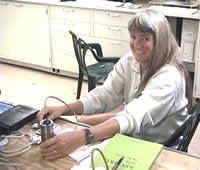|
Participant Perspective - July
22, 2001
 Interview
with Susan Hanneman Interview
with Susan Hanneman
Research Assistant / Navigator NOAA/PMEL
Jeff:
When did you work at Bob Embley's lab as his research assistant.
Susan:
From 1985 to 1991 I worked with the NOAA EOI Program. Since then
they've hired me to work on a part-time basis to go to sea when they need
camera
sled work, navigation or general support. It really makes you feel like
an
antique when most of the ships you started on have been decommissioned
and
sold
to developing countries.
Jeff:
How have you seen Axial change since you first came here in 1985?
Susan:
I thought I would recognize some of the ASHES vent field chimneys such
as Hell but the only one that looks the same is the anhydrite chimney
Virgin. Even though I recognize some of the feature names there are so
many new ones that weren't there when I first came. It's certainly changed
through sampling and through all the years, 1985 till now. Yikes.
Jeff:
How has the technology changed since you first started with the
Vents
Program in 1984?
Susan:
When I first started we packaged positions by recording wire out from
the winch and looking at the wire angle and then doing the trigonometry
to calculate its position behind the ship. We had some really crude navigational
programs. Then we started getting GPS (global positioning system) but
it wasn't 24 hours like it is now. You might get a few satellites at a
certain time of day. We'd still have to plot on mylar on the ship. Now
it's changed quite a bit. We have SeaScape software that almost anybody
can just go boot up and the transponders will tell you pretty much where
you are and where you're targets are. It's real-time instant gratification.
We also have wonderful plots of bathymetry shaded for topography. It's
just gorgeous. It's a whole different ball game. The first ship I went
on actually had a "secret room" where the SeaBeam was kept and
unless you had a clearance, you couldn't go in there because anything
inside the EEZ (Exclusive Economic Zone within 200 miles of the coast)
was classified for submarine surveillance stuff. Now there are certainly
better facilities. Back in the old days you didn't hear from home unless
you wanted to spend $10 a minute on an INMARSAT call. So, basically you're
out of touch unless there was an emergency or you were independently wealthy.
Now you can go around to several computers on the ship and get email twice
a day.
Jeff:
Did you dive exclusively with manned subs?
Susan:
Yeah. We didn't have any ROV's. I can't imagine how many Alvin dives and
other subs Bob Embley has logged. There's no one that wouldn't want to
go down on a sub dive because it's just so cool. At the same time, with
the ROV, so many people participate in one dive that economically it can't
be beat and they are getting better all the time. The ROPOS guys just
removed a tie wrap today at the bottom. With a little finger they popped
it. Amazing. Firsthand observation is great but frankly you're not out
there anyway. You're still looking through a view port. With the video
cameras now it's wonderful. I suspect that ROV's and even autonomous vehicles
are the future. Subs have their uses too, but when you can have 30-some
people in the science party and you can stay down for days at a time,
ROV's can't be beat. With less deployments and recoveries there's less
risk to gear and less time lost. The first time I was on the Tully and
I saw 15 scientists standing around participating on a dive. It was much
better than going down and coming up with two people sharing what they
saw. It's definitely a step in the right direction.
|

